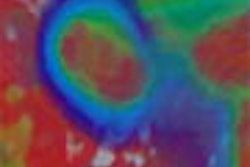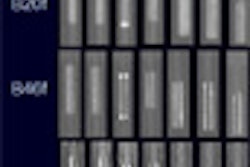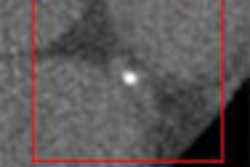Interactive image display methods for multidetector CT coronary angiography exams yield higher diagnostic accuracy than prerendered images, according to an article in the June issue of Radiology.
"Interactive evaluation of multidetector CT coronary angiography datasets on a workstation should ... be the preferred way of interpretation," wrote a research team from Massachusetts General Hospital and Harvard Medical School in Boston and the University of Erlangen in Germany.
The research team sought to retrospectively evaluate the diagnostic accuracy of multidetector CT angiography in detecting significant (50% or more ) stenoses using various image processing methods (Radiology, June 2007, Vol. 243:3, pp. 696-702).
Multidetector CT datasets were obtained for 40 consecutive patients using a Sensation 16 scanner (Siemens Medical Solutions, Erlangen, Germany), acquiring 16 sections at 0.75-mm collimation, 120 kVp, 550 mAs, and 375-msec gantry rotation time. Transverse images were transferred to a Leonardo off-line workstation (Siemens).
After one observer prepared the datasets for further evaluation, six independent investigators experienced in cardiac CT imaging evaluated the datasets for the presence of stenoses with diameter reduction of 50% or more, using either exclusively transverse images, free oblique multiplanar reconstructions (MPR), free oblique maximum intensity projections (MIP, 5 mm thick), prerendered curved MPRs, prerendered curved MIPs, or prerendered 3D volume-rendered reconstructions (VRTs).
The readers, blinded to the conventional angiography data, used only one method to avoid any influence of prior knowledge from having evaluated the same dataset using another method, according to the authors. Each artery was also classified as either evaluable or nonevaluable. The results were then compared with conventional coronary angiography, which had been performed in all patients one day after multidetector CT.
Overall, there were 35 coronary artery stenoses greater than 50% diameter reduction seen on conventional angiography. Of these 35, transverse images had 99% of evaluable arteries and 88% accuracy in accurately detecting stenosis, while oblique MPR had 99% and 91%, respectively. Oblique MIP had 94% of evaluable arteries and 86% accuracy for detecting stenosis, while curved MIP had 94% and 83%, respectively. VRT showed 91% of evaluable arteries and 73% accuracy for detecting stenosis.
The researchers determined that accuracy was significantly higher for oblique MPR than for curved MPR (p = 0.01), curved MIP (p = 0.03), and VRT (p < 0.001).
The authors acknowledged several limitations in the study, including its small sample and lack of formal power analysis. In addition, data were acquired using 16-section CT scanners, while 64-section scanners with faster rotation times are now available, according to the authors. The researchers did not expect to find a systematic difference, however, when transferring results to 64-section CT.
"The results of our investigation showed that the evaluation of multidetector CT coronary angiograms with interactive image display methods, especially with MPRs, provided higher diagnostic accuracy than did evaluation limited to the analysis of prerendered images (curved MPR, curved MIP, and 3D VRT images)," the authors concluded.
By Erik L. RidleyAuntMinnie.com staff writer
May 31, 2007
Related Reading
Study correlates CTA to angiography, myocardial perfusion SPECT, May 25, 2007
Dual-source coronary CTA detects reduction in lumen diameter, May 24, 2007
Dual-source coronary CTA images the calcium-burdened, April 13, 2007
ACC study: Dual-source cardiac CT delivers acceptable radiation dose, March 28, 2007
Copyright © 2007 AuntMinnie.com




















